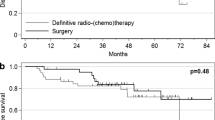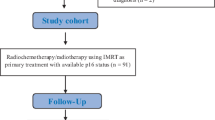Abstract
Objective
The goal of this study is to evaluate patterns of failure and survival in relation to HPV/p16 status in patients with oropharyngeal (OP) cancers who were treated with chemoradiotherapy.
Methods
A retrospective review of 271 consecutive head and neck cancer patients with known HPV/p16 status treated between 2009 and 2012 were reviewed. Ninety-four were identified OP cancers. Ninety-five percent of patients were treated with intensity-modulated radiation therapy (IMRT) with or without systemic therapy. Diagnostic imaging was coregistered with the planning CT scan in order to assess radiation dose statistics for the failure site.
Results
The median follow-up time was 30 months. The estimated 3-year overall survival for the cohort was 63 %. There was a trend for improved survival in HPV/p16+ patients compared to HPV/p16− patients (75 vs 58 %, p = 0.052). Heavy smoking was related to worse survival. There was a nonsignificant increase in locoregional failure (15.4 vs 2.8 %, p = 0.127) and distant metastasis (12.5 vs 1.5 %, p = 0.108) in HPV/p16− compared to HPV/p16+ tumors. No neck failures occurred in the HPV/p16+ patients, while six neck failures occurred in HPV/p16− patients. There was no difference between elective nodal doses between the two groups. A lower mean elective nodal dose was significant for predicting neck failure (44.54Gy vs 55.19Gy, p = 0.042).
Conclusion
HPV/p16− patients have trends toward worse overall survival, locoregional recurrence, and distant metastasis. Lower elective nodal doses in HPV/p16− patients may increase the risk for elective neck failure.




Similar content being viewed by others
References
Sikora AG, Toniolo P, DeLacure MD (2004) The changing demographics of head and neck squamous cell carcinoma in the United States. Laryngoscope 114(11):1915–1923
Mehanna H, Beech T, Nicholson T, et al. Prevalence of human papillomavirus in oropharyngeal and nonoropharyngeal head and neck cancer-systematic review and meta-analysis of trends by time and region. Head Neck 2012
Chaturvedi AK, Engels EA, Pfeiffer RM et al (2011) Human papillomavirus and rising oropharyngeal cancer incidence in the United States. J Clin Oncol 29(32):4294–4301
Shiboski CH, Schmidt BL, Jordan RC (2005) Tongue and tonsil carcinoma: increasing trends in the US population ages 20–44 years. Cancer 103(9):1843–1849
Colevas AD. Population-based evaluation of incidence trends in oropharyngeal cancer focusing on socioeconomic status, sex, and race/ ethnicity. Head Neck 2013
Ang KK, Harris J, Wheeler R, Weber R et al (2010) Human papillomavirus and survival of patients with oropharyngeal cancer. N Engl J Med 363(1):24–35
Rischin D, Young RJ, Fisher R et al (2010) Prognostic significance of p16INK4A and human papillomavirus in patients with oropharyngeal cancer treated on TROG 02.02 phase III trial. J Clin Oncol 28(27):4142–4148
Gillison ML, D’Souza G, Westra W et al (2008) Distinct risk factor profiles for human papillomavirus type 16-positive and human papillomavirus type 16-negative head and neck cancers. J Natl Cancer Inst 100(6):407–420
Fakhry C, Westra WH, Li S et al (2008) Improved survival of patients with human papillomavirus-positive head and neck squamous cell carcinoma in a prospective clinical trial. J Natl Cancer Inst 100(4):261–269
Posner MR, Lorch JH, Goloubeva O et al (2011) Survival and human papillomavirus in oropharynx cancer in TAX 324: a subset analysis from an international phase III trial. Ann Oncol 22(5):1071–1077
Lassen P, Eriksen JG, Krogdahl A et al (2011) The influence of HPV-associated p16-expression on accelerated fractionated radiotherapy in head and neck cancer: evaluation of the randomised DAHANCA 6&7 trial. Radiother Oncol 100(1):49–55
Benson E, Li R, Eisele D et al. The clinical impact of HPV tumor status upon head and neck squamous cell carcinomas. Oral Oncol (2013)
Ang KK, Sturgis EM (2012) Human Papillomavirus as a marker of the natural history and response to therapy of head and neck squamous cell carcinoma. Semin Radiat Oncol 22:128–142
Mehra R, Ang KK, Burtness B (2012) Management of human papillomavirus-positive and human papillomavirus-negative head and neck cancer. Semin Radiat Oncol 22:194–197
Chen AM, Li J, Beckett LA et al (2012) Differential response rates to irradiation among patients with human papillomavirus positve and negative oropharyngeal cancer. Laryngoscope 123:152–157
Gillison ML, Koch WM, Capone RB et al (2011) Evidence for a causal association between human papillomavirus and a subset of head and neck cancers. J Natl Cancer Inst 92:709–720
Ang KK, Zhang QE, Rosenthal DI, et al. A randomized phase III trial (RTOG 0522) of concurrent accelerated radiation plus cisplatin with or without cetuximab for stage III-IV head and neck squamous cell carcinomas (HNC) J Clin Oncol 2000;29(suppl):360s, abstr 5500
Forastiere AA, Goepfert H, Maor M et al (2003) Concurrent chemotherapy and radiotherapy for organ preservation in advanced laryngeal cancer. NEJM 349:2091–2098
Posner MR, Hershock DM, Blajman CR et al (2007) Cisplatin and fluorouracil alone or with docetaxel in head and neck cancer. NEJM 357:1705–1715
O'Sullivan B, Huang SH, Perez-Ordonez B et al (2012) Outcomes of HPV-related oropharyngeal cancer patients treated by radiotherapy alone using altered fractionation. Radiother Oncol 103:49–56
Huang SH, Perez-Ordonez B, Liu FF et al (2012) Atypical clinical behavior of p16-confirmed HPV-related oropharyngeal squamous cell carcinoma treated with radical radiotherapy. Int J Radiat Oncol Biol Phys 82:276–283
Corry J, Peters LJ, Rischin D (2010) Optimising the therapeutic ratio in head and neck cancer. Lancet Oncol 11:287–291
Koutcher L, Sherman E, Fury M et al (2011) Concurrent cisplatin and radiation versus cetuximab and radiation for locally advanced head-and-neck cancer. Int J Radiat Oncol Biol Phys 81:915–922
O'Sullivan B, Huang SH, Siu LL et al (2013) Deintensification candidate subgroups in human papillomavirus–related oropharyngeal cancer according to minimal risk of distant metastasis. JCO 31(5):543–550
Mendenhall WM, Million RR, Cassisi NJ (1980) Elective neck irradiation in squamous-cell carcinoma of the head and neck. Head Neck Surg 3:15–20
.M. Chow, B.C. Levin, J.S. Krivit et al. Radiotherapy or surgery for subclinical cervical node metastases. Arch Otolaryngol Head Neck Surg, 1989;115:981–984
Langendijk JA, Doornaert P, Rietveld DH et al (2009) A predictive model for swallowing dysfunction after curative radiotherapy in head and neck cancer. Radiother Oncol 90:189–195
Nuyts S, Lambrecht M, Duprez F, et al. Reduction of the dose to the elective neck in head and neck squamous cell carcinoma, a randomized clinical trial using intensity modulated radiotherapy (IMRT). Dosimetrical analysis and effect on acute toxicity. Radiotherapy and Oncology 2013
Conflicts of interest
Ram Narayan, Joseph Shaughnessy, Craig Silverman, Jeffrey Bumpous, Kevin Potts, Rebecca Redman, Elizabeth Cash, Christine Swanson, and Liz Wilson declare that they have no conflicts on interest.
Neal Dunlap has received an honorarium from the Institute of Graduate Medical Education for educational lectures.
IRB Statement
IRB permission was obtained prior to conducting this retrospective analysis. A complete waiver was placed in each patient’s chart. IRB # BCC-13.0145
Author information
Authors and Affiliations
Corresponding author
Rights and permissions
About this article
Cite this article
Narayan, R., Shaughnessy, J., Silverman, C. et al. The relationship between patterns of failure and human papilloma virus (HPV) status for squamous cell carcinoma of the oropharynx after definitive chemoradiotherapy: what role does elective nodal irradiation play?. J Radiat Oncol 4, 47–53 (2015). https://doi.org/10.1007/s13566-014-0174-3
Received:
Accepted:
Published:
Issue Date:
DOI: https://doi.org/10.1007/s13566-014-0174-3




